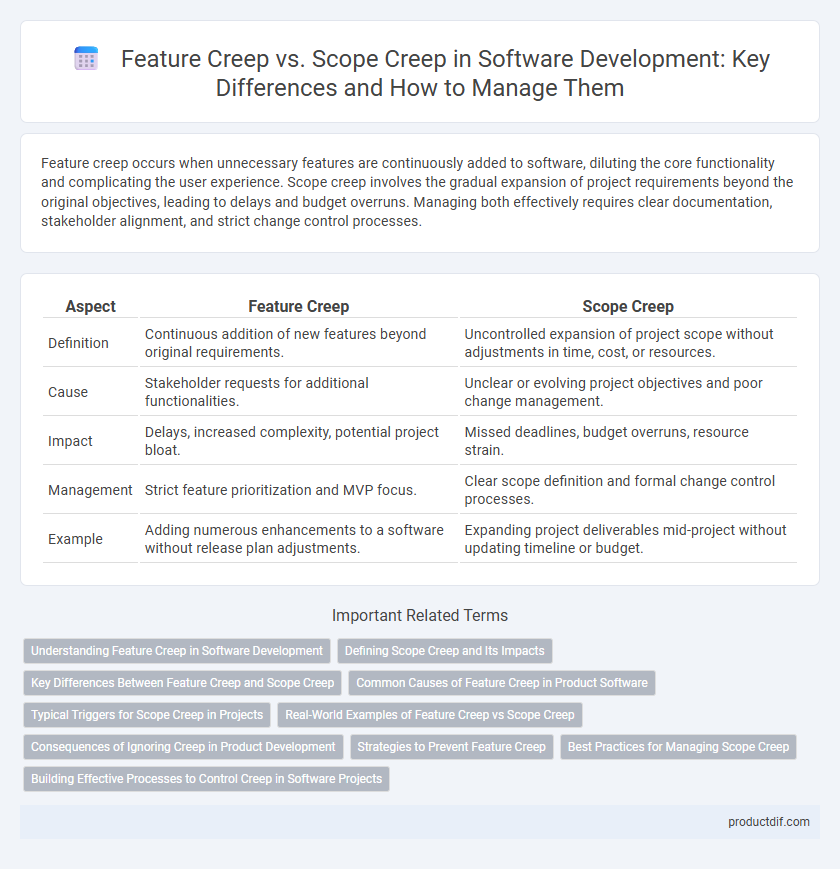Feature creep occurs when unnecessary features are continuously added to software, diluting the core functionality and complicating the user experience. Scope creep involves the gradual expansion of project requirements beyond the original objectives, leading to delays and budget overruns. Managing both effectively requires clear documentation, stakeholder alignment, and strict change control processes.
Table of Comparison
| Aspect | Feature Creep | Scope Creep |
|---|---|---|
| Definition | Continuous addition of new features beyond original requirements. | Uncontrolled expansion of project scope without adjustments in time, cost, or resources. |
| Cause | Stakeholder requests for additional functionalities. | Unclear or evolving project objectives and poor change management. |
| Impact | Delays, increased complexity, potential project bloat. | Missed deadlines, budget overruns, resource strain. |
| Management | Strict feature prioritization and MVP focus. | Clear scope definition and formal change control processes. |
| Example | Adding numerous enhancements to a software without release plan adjustments. | Expanding project deliverables mid-project without updating timeline or budget. |
Understanding Feature Creep in Software Development
Feature creep in software development refers to the excessive addition of new features that go beyond the original project requirements, leading to increased complexity and potential delays. This phenomenon often results from unclear project goals, stakeholder pressure, or desire to enhance user experience without proper impact analysis. Managing feature creep requires strict prioritization, effective communication, and continuous validation of feature relevance to maintain product quality and timeline.
Defining Scope Creep and Its Impacts
Scope creep refers to the uncontrolled expansion or changes in a software project's requirements beyond its initial objectives, often occurring without proper approval or assessment. This phenomenon can lead to increased development time, budget overruns, and reduced product quality due to shifting priorities and resource misallocation. Effectively managing scope creep involves clear documentation, stakeholder communication, and strict adherence to project scope baselines to minimize its adverse impacts.
Key Differences Between Feature Creep and Scope Creep
Feature creep involves the continuous addition of new features beyond the original project plan, often leading to increased complexity and delays. Scope creep refers to uncontrolled changes or expansions in the overall project scope, impacting timelines and budget. Key differences include feature creep targeting product functionality, while scope creep affects the broader project parameters and deliverables.
Common Causes of Feature Creep in Product Software
Feature creep in product software commonly arises from unclear project requirements, evolving user demands, and inadequate prioritization during development cycles. Stakeholder pressure to continuously add functionalities without assessing the impact on timelines and resources exacerbates uncontrolled expansion. Insufficient communication between product managers, developers, and clients often leads to ambiguous objectives, resulting in unnecessary feature additions that complicate the software's core purpose.
Typical Triggers for Scope Creep in Projects
Typical triggers for scope creep in software projects include unclear project requirements, frequent stakeholder changes, and poor communication among team members. Inadequate initial planning and evolving client demands often lead to unplanned tasks and expanded deliverables. Managing scope effectively requires rigorous documentation and strict change control processes to prevent project delays and budget overruns.
Real-World Examples of Feature Creep vs Scope Creep
Facebook's transition from a simple social networking site to a multifaceted platform illustrates feature creep, where incremental additions like Marketplace and Watch led to complex user experiences. NASA's Mars Climate Orbiter failure serves as a scope creep example, where changing project requirements without proper adjustments caused a costly mission loss. These cases highlight the risks of unmanaged feature and scope expansions in software project management.
Consequences of Ignoring Creep in Product Development
Ignoring feature creep and scope creep in product development often leads to delayed project timelines, increased costs, and compromised product quality. Unchecked creep causes resource misallocation, resulting in team burnout and reduced stakeholder satisfaction. Persistent scope and feature creep undermine the product's initial vision, causing market misalignment and decreased competitive advantage.
Strategies to Prevent Feature Creep
Implementing clear project requirements and maintaining strict change control processes are essential strategies to prevent feature creep in software development. Prioritizing features based on user needs and business value ensures the team stays focused on delivering core functionalities without unnecessary additions. Regular stakeholder communication and iterative reviews facilitate early detection of scope deviations, minimizing the risk of uncontrolled feature expansion.
Best Practices for Managing Scope Creep
Effective management of scope creep in software development requires clear documentation of project requirements and frequent stakeholder communication to ensure alignment. Implementing change control processes and prioritizing features based on business value minimizes unauthorized expansions and keeps the project on track. Utilizing agile methodologies and regular backlog grooming allows for flexible adjustments while maintaining focus on core deliverables.
Building Effective Processes to Control Creep in Software Projects
Establishing clear project requirements and continuous stakeholder communication mitigates feature creep by preventing unnecessary additions beyond initial objectives. Implementing strict change control processes ensures any scope alterations are evaluated for impact on timelines and resources, reducing scope creep risks. Utilizing project management tools that track progress and changes enhances visibility, enabling teams to respond effectively to creep before it jeopardizes project delivery.
Feature Creep vs Scope Creep Infographic

 productdif.com
productdif.com